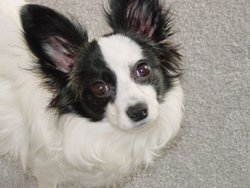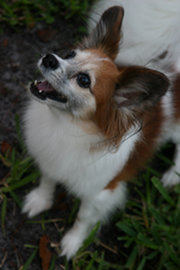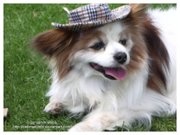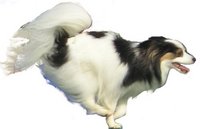Papillon
Dogs
Papillon
| Papillon |

The Papillon's large, butterfly-like ears gave the breed
its name.
|
| Alternative names |
Butterfly Dog
Phalène (drop ear type)
Continental Toy Spaniel
Epagneul Nain Continental
Squirrel Dog (because of tail carriage) |
| Country of origin |
|
France |
| Common nicknames |
| |
| Classification and breed standards |
|
FCI: |
Group 9 Section 9 #77 |
|
|
AKC: |
Toy |
|
|
ANKC: |
Group 1 (Toys) |
|
|
CKC: |
Group 5 - Toys |
|
|
KC (UK): |
Toy |
|
|
NZKC: |
Toy |
|
|
UKC: |
Companion Breeds |
|
| Not recognized by any major kennel club |
| This breed of dog is
extinct |
| Notes |
| |
The Papillon is a small
dog with large,
luxurious ears that earned it its name, the
French word for butterfly. The Papillon is believed to be one of the
oldest of the toy
breeds.
Appearance
 The Papillon comes in several colors. This one does not meet the breed standard
criteria for facial coloration.
The Papillon comes in several colors. This one does not meet the breed standard
criteria for facial coloration.
The modern Papillon bred according to the official
breed standard is required to have an abundant, flowing coat, which is
considered proper only if it is a single coat (i.e., has no fluffy or cottony
undercoat), short on the head but profuse around the neck, chest, and
pantaloons
or culottes. The tail should be a plume of long hair. A proper single coat
ensures relatively low maintenance in grooming. The large, erect, and fringed
ears are the most notable physical attribute of the erect-eared breed today. The
Phalène is
the same as the erect-eared Papillon except for its dropped
spaniel-like
ears. The
AKC considers the Phalène a variant of the Papillon and judges them together
as the same breed; countries whose
breed clubs
follow the FCI
standard consider Papillons and Phalènes two separate breeds. This belief is
common, but the fact is that Papillon is a variant of the much older race
Phalène.
Papillons should always be white with another color. Most common are the black
and white, sable and white, red and white, and tri-color papillons. The color
should always cover both eyes and the front and back of the ear to give the
proper butterfly look. A white blaze and noseband are preferred as they also
contribute to the correct butterfly look of the dog. Size should range from 8
inches to 12 inches at the shoulder (11 inches in the UK) with the average
papillon being between 9 and 10.5 inches in height and weight in proportion.
Temperament
 The Papillon is not the dainty breed that most suspect.
The Papillon is not the dainty breed that most suspect.
Even though the breed has the connotation of a dainty toy breed, many owners
will tell you they act like big dogs in small dogs' bodies. There are several
possible reasons for this. First, the Papillion is hardy; some people believe
the Papillon is very capable of handling a good five-mile walk. Some owners
believe the reality is that they will resist such an outing if the grass is
dampish or if there are two clouds in the sky that might lead to rain, but
others have experienced them as very versatile in almost all conditions,
although not necessarily with prolonged exposure. Perhaps they seem to be larger
dogs because to many people Papillons appear not to be prone to small dog
quaking when confronted with a new situation. In fact, some Papillon owners
believe that their dogs interpret any new event as having been put on for their
benefit, and believe that the dogs do their best to be an attentive host or
hostess. Another aspect of the Papillon that has led many to believe the 'big
dog' assertion is that this breed is surprisingly athletic. Perhaps people are
surprised that in contrast to its staid and stately representation in the Old
Master portraits, the Papillon is highly energetic and intelligent (Stanley
Coren, in
The Intelligence of Dogs, rates the Papillon eighth among all breeds).
Provided their genetic structure is sound and they are healthy, Papillons are
built for movement, and most do not need any encouragement to apply their energy
to athletic activities.
History
The Papillon probably originated in continental Europe and was a favorite at
the French court. The most famous owner was
Henry III; documentation of his devotion to the breed lies in his
declaration of the Papillon as the official dog of the Royal Court during his
tenure. Other famous owners are said to have been
Marie Antoinette, and
Madame de Pompadour.
There is evidence that these small dogs were favorites of European
aristocrats, particularly French royalty, during the time of the
Old Masters,
as Continental Toy Spaniels (Phalènes
and Papillons) were included in many Old Master royal portraits from as early as
the sixteenth century.
 The Papillon is a highly athletic breed.
The Papillon is a highly athletic breed.
There are many stories about the Papillon. Marie Antoinette was said to have
walked to the
guillotine
clutching her small dog under her arm. Tradition has it that her dog was a small
spaniel that
had been brought to the French court from
Spain on the back
of pack mules. According to the story, her pup was spared and cared for in a
building in Paris still called the
Papillon House. Marie's small spaniel was said to have descended from a very
old drop-eared breed known as the Epagneul Nain Continental, or Continental
Dwarf/Toy Spaniel that appeared in church
frescos and
paintings as early as the
13th
century.
The Papillon is still officially referred to as the Epagneul Nain
Continental (ENC) in non-English-speaking countries. The name Squirrel
Spaniel also has been used, most likely referring to an earlier standard in
which the tail set is described as "curling over the back as a squirrel's." One
version of the history of the two varieties of ear shape in the ENC ("Papillon"
to denote the erect ear and "Phalène" to denote the dropped ear) is that toward
the end of the
19th
century, breed fanciers bred a version of the spaniel whose ears stood up.
This dog was said to have been nicknamed papillon based on the
impressively large, erect ears that resembled the wings of a butterfly. The
drop-eared variety of the breed came to be called the Phalène (which means
"moth"). Both types are still bred today and appear in the same litter. The
Papillon variety is much more common, although recently the Phalène has
undergone a resurgence in popularity.
Dog Agility
In recent years, the Papillon has become a small dog star in the sport of
dog
agility. This sport consists of an obstacle course with tunnels, jumps,
A-frames, and narrow bridges that a dog completes at top speed aided only by
verbal and body-language commands from a handler. Agility requires the dog to
spring, scramble, weave, and turn on a dime. The breed is considered naturally
agile, and Papillons compete at both national and international trials. Because
many Papillons have intense drive and natural speed, their tiny turning
radius gives
them an edge over larger dogs, and some Papillons are capable of beating even
Border Collie speeds on some courses. At the same time, Papillons excel in
companionship and lap dog sweepstakes, and take it very seriously. The first dog
to ever earn a
MACH title in Alaska is a Papillon.
Others have experienced Papillons as highly companionable—yet physically
active—dogs requiring appropriate socialization, consistent and monitored
exercise, continued training (which also serves to stimulate their active
minds), and daily, proactive human-to-canine interaction.
Home | Up | Papillon | Parson Russell Terrier | Patterdale Terrier | Pekeapoo | Pekingese | Pembroke Welsh Corgi | Perro de Presa Canario | Peruvian Hairless Dog | Petit Basset Griffon Vendeen | Phalène | Pharaoh Hound | Plott Hound | Polish Lowland Sheepdog | Polish Scenthound | Pomeranian | Pont-Audemer Spaniel | Poodle | Poodle Hybrid | Portuguese Podengo | Portuguese Water Dog | Pudelpointer | Pug | Puli | Pumi | Pyrenean Mountain Dog | Pyrenean Shepherd
Dogs, made by MultiMedia | Free content and software
This guide is licensed under the GNU
Free Documentation License. It uses material from the Wikipedia.
|




